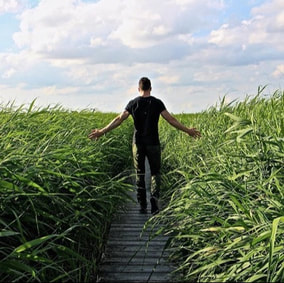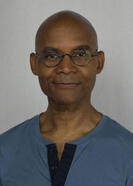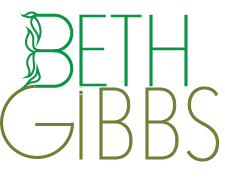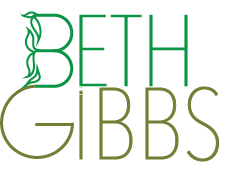ENLIGHTEN UP! a blogSelf-awareness stories: lighting our way to clarity, contentment and resilience in a complicated world.
|
 Guest Post by Per Erez “Without movement life is unthinkable.” - Moshe Feldenkrais As a youth, I was constantly on the go mentally. When my siblings complained of boredom, I found my attention and interest easy to maintain. On the other hand, I had difficulty learning how to climb trees, ride a bike, and fish. I have memories of bruised ribs, shins, and scars from my attempted activities. I was a quick study in most school subjects, but handling a soccer ball was devastatingly alien and frustrating. I aspired to be a tomboy because I wanted to impress my peers. I was hopelessly bookish, though, and prone to pratfalls. Moving my mind and thinking came naturally, but bodily coordination required monumental effort. When I eventually chose a sport to participate in high school, non-contact activities were my best option. Running cross country saved my life at this point. By running, I accidentally stumbled into a practice that unified my body and mind. It was a simple way to organize myself, moving through time and space. My self-talk during those hundreds of miles likely helped me navigate the physical terrain and the deeper issues of teenage life. This was the first time I remember realizing movement could bring joy. The one constant of life is that everything must move. All life moves into creation and must continue moving to propel itself forward. Movement is a necessity from which vitality and potency arise. Motion is a core reality—from our big bang theory to sperm cells swimming towards an egg— all organic life must obey it. What meaning can we make of the growing number of people living sedentary lifestyles in the 21st century then? Why has morbid obesity (one of the numerous chronic conditions plaguing society) become epidemic? I suspect a dysfunctional relationship with movement is a part of the answer. And that that relationship is in part rooted in how we understand ourselves as living beings. We refer to our species as homo sapiens or the "thinking people." And, thinking has been advantageous for evolution. But higher-order thinking is a byproduct of moving. We emphasize thinking, which misses natural movement as a primary organizing principle for life. Imagine you were to leave your hand on a hot stove and consider your options before removing it. Luckily, this doesn't happen because we move in response to stimulus. The impulse that swept us from our cozy rent-free wombs taught us to move, feel, and learn to adapt to our environment. Most people live as if after we reach physical maturity, we are no longer obligated to move as a means of learning. But sedentary behavior negatively impacts how we relate to the world. It skews how we experience ourselves. Between our first crying breath and last exhale, the choice to develop our somatic intelligence, or the embodied experience of living uniquely as ourselves, still exists. The language of movement is the means to uncover that experience directly. Moving and thinking, however, have long been in opposition. The Cartesian idea of body and mind as separate spheres places the cart of thought before the horse of movement and almost untethers them. Our technologically sophisticated culture has only deepened this paradox. To promote joy through movement, perceiving ourselves as creatures whose actions also inform how we think is vital. We move; therefore, we are. Squarely centering movement might better address many physical and psychological issues we regularly attempt to medicate. A consistent practice of walking, for instance, can profoundly improve digestion, cardiovascular health, and elimination. Movement education is also necessary for addressing "motor amnesia," the inability to move well. Movement accuracy and efficiency suffer when sensory feedback is weak. The expression "use it or lose it" is the bedrock of the nervous system. Motor and sensory feedback connect in the brain like two sides of a coin. Both components are cross-wired so that information flows backward or forwards as necessary. Diminishing our movements impacts the body's systems and capability over time. The effects usually go unnoticed because the link between sensing motion, and moving itself, is dependent on being aware in the first place. It becomes critically important in cases of the elderly, who are more prone to severe injuries due to poor balance and coordination deficits. Much of what we consider "aging" could result from the slow erosion of healthy movement. Thinking of aging as an unavoidable slide towards oblivion is still a widespread cultural value. We set up each generation's poor health and well-being outcomes by preferring the myth that life amounts to a slow-motion decline, rather than realizing that living systems require movement. Some aspects of aging are authentic nonetheless. A productive life is possible in your 80s and 90s, as proven amongst the "blue zones" of the world. These are the global hotspots where elderly people naturally maintain wellness through lifestyles that favor culturally appropriate exercises, foods, and social engagement. The gradual decline in physical activity— more than worn-out joints and the slowdown of metabolism— is more likely a culprit to age-related poor health outcomes in many developed countries. A more verifiable marker for loss of well-being does exist though. The inability to rise from prone to standing with minimal hand bracing. In one study, lacking this skill was a higher determinant for the likelihood of premature death within six years than many other factors. When we use movement to learn, it extends far beyond functional fitness or even health and longevity concerns. Movement is medicine, but moving from point A to point B is just the start. I have discovered that my movement reveals who I am. I see personal growth from my earliest years of movement incompetence to the expertise I possess today. By paying attention to how I embody movement, my life has prospered. And observing others move their bodies is especially pertinent here as a professional facilitator because I have witnessed dramatic reversals in students and clients. I am viscerally reminded of the profound gift a moving body represents, just as when I started my journey as a distance runner. I feel who I am through my skin, muscles, joints, and bones, and I know how my nervous system attunes to each moment via motion. My feelings (often located just beneath the surface of my actions) are observable in how I orient myself in space. My posture and physical mannerisms are more clearly legible in my structure and stance. Before my thinking brain has a chance to craft a story about who I am, you see me in my movements. It's how we identify one another. We recognize intimate others when we can't see their faces or at great distances. We read each other's body movements. Importantly, if I change my mind, I have noticed that how I move tells how native the fabric of my body aligns with the assertion. It's not as simple as "how we move is how we think." But it clarifies the relationship between living in motion and thought. Movement is an opportunity to study who you are and become who you want to be. Initially, it reflects the opportunity for you to become a healthier and more vital version of yourself. Ultimately the journey with movement can lead to innate happiness.  Per Erez, CHSE, C-IAYT, RSME/T has practiced and studied consciousness-based movements for most of his adult life. He holds accreditations in several movement disciplines. His interests revolve around bringing yoga therapy and somatic education into modern health and wellness. Erez has worked in a wide array of settings, such as traditional yoga centers, corporations, health clubs, dance studios, hospitals, social service agencies, and a stint with Oprah Winfrey and members of the royal House of Saud. He practices Yoga Therapy and Somatic Education and lives in Palm Springs.
1 Comment
Your comment will be posted after it is approved.
Leave a Reply. |
Archives
July 2024
AuthorBETH GIBBS started her yoga practice in 1968, four months after her son was born and she’s been practicing ever since. She currently teaches all levels therapeutic yoga classes for adults, and specialty classes for seniors in the Hartford, Connecticut area. Beth is a certified yoga therapist through the International Association of Yoga Therapists and is guest faculty at the Kripalu School of Integrative Yoga Therapy. She writes for the blogs, Yoga for Healthy Aging, and Accessible Yoga. Her master’s degree from Lesley University in Cambridge, MA is in Yoga Therapy and Mind/Body Health. Categories |
|
|
Enlighten Up! a Blog
|
Copyright © 2023 Beth Gibbs

 RSS Feed
RSS Feed
